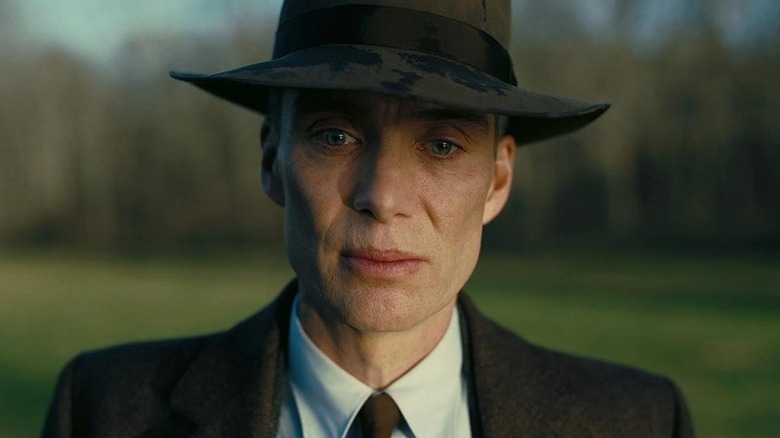Oppenheimer's Opening Scene Broke One Of Christopher Nolan's Own Filmmaking Rules
If there's any one thing Christopher Nolan has shown throughout his last several movies, it's that he's a constantly evolving filmmaker. After getting "The Dark Knight" trilogy out of his system, his approach on the introspective and achingly heartfelt "Interstellar" couldn't feel more different from the operatic heroics of "Dunkirk." In the same way, "Tenet" feels like Nolan finally letting his hair down (so to speak) for an unexpectedly "vibes only" movie right before following it up with his grandest and most sobering film yet in "Oppenheimer." But amid such varied work, a common thread between them all is that Nolan simply can't resist bringing things full circle.
"Oppenheimer" is certainly no exception to that rule, particularly as it charts the life of J. Robert Oppenheimer's (Cillian Murphy) from his early days at Cambridge up until his post-World War II inquest into his security clearance and beyond. The decades of stress, depression, and guilt were hardly kind to the controversial figure, as the opening and closing shots of the film make painfully clear. Yet as studious and exacting as Nolan tends to be (there likely won't be a single deleted scene available on the home media release, unsurprisingly), the detail-oriented filmmaker admitted that he and his creative team actually hadn't planned out the film's opening scene as we saw it in its final form.
In a relatively recent interview, Nolan explained how the symmetry between the rain and the opposing closeups of Murphy's tortured face came about in the edit — not the script.
Of water and nuclear war
After its chilling opening title card describing Prometheus stealing fire from the gods and bestowing this gift upon humanity, only to be punished for eternity for the trouble, "Oppenheimer" opens on its eponymous figure observing raindrops falling on a puddle somewhere in the Cambridge campus. Juxtaposed against fleeting imagery of the microscopic world and visuals echoing violent nuclear explosions, it's as if even a young Oppenheimer was constantly plagued by how his actions could bring damnation onto the entire world. Even nature is no escape.
When the film concluded with a very similar close-up of a much older Oppenheimer gazing out towards raindrops falling on a pond, fans naturally assumed this was another instance of Christopher Nolan's penchant for parallel and downright poetic filmmaking. It obviously worked out that way, but it wasn't quite as planned out as most would've thought. In an interview with BBC Radio, Nolan revealed how that opening shot came to be:
"It's not in the script, actually, which for me is very rare. It's a sort of symbol, a symbolic representation that started to insert itself in the filming. I'm a very controlled and controlling filmmaker, and I don't often shift something as important as that, but it was something that just kept pulling us in and pulling us in that we kept repeating in the filming. Myself and [director of photography] Hoyte van Hoytema and Cillian, you know, just finding this. And working with Jen [Lame] in the edit suite relatively late, we realized that that's exactly the opening."
The haunting bookends play a large part in tying together the whole epic, tragic saga of Oppenheimer, but it goes to show how much the Film Gods can have the final say in things — oftentimes for the better.

